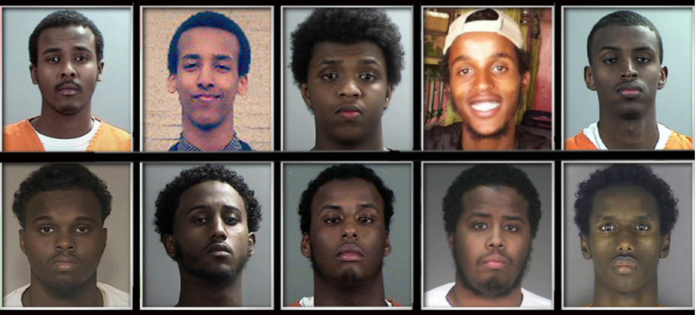
During the trial of the nine ISIS recruits in Minneapolis last week, US District Court Judge Michael Davis repeatedly stressed the fact that there is a terrorist cell in Minneapolis.
The Star Tribune reported:
“Davis repeatedly underlined a clear message: There is a terrorist cell in Minneapolis and it is still alive today.
Each day, Davis sought to extract acknowledgment from the young men that they were “terrorists,” and left no doubt as to his thoughts on whether they were simply misguided youths.
Saying the Minnesota public had “danced around” the issue, Davis described the cell’s size as being between nine to 20, including those sentenced last week and others killed abroad.
Later in the week, he raised eyebrows in the courtroom by telling one defendant that he noted “six to 10” supporters who attended previous hearings and insisted that “some defendants gave them signals.”
“I know they’re out there,” Davis said. “The community knows they’re out there.”
As Alpha News reported, prior to the sentencings, recently elected MN Representative, Ilhan Omar, wrote a letter imploring Judge Davis for “compassion” and a “restorative approach to justice” for the men. A MPR News article from April 2015 may show insight into Omar’s request for compassion for the men convicted of attempting to join ISIS: Omar told MPR News that she had been friends with some of the defendants as a teenager, “they were just normal kids. They were popular, went camping and played sports. ‘They were happy young men.’”
As was shown in the April 2015 MPR News article, Omar, along with other leaders within Minnesota’s Somali population, has been a critic of the million dollar “Countering Violent Extremism” program established in Minnesota by the Department of Justice. “Countering Violent Extremism,” also known as the “Building Community Resilience” plan, focuses on delivering resources to Minnesota’s Somali population “to address the root causes of terrorism” through community and public partnerships.
A US Department of Justice report, “Combatting Terror Recruiting,” outlines how Minnesota is a focal point for terror recruiters. In April of 2015, US Attorney Andrew Luger stated, “We have a terror recruiting problem in Minnesota.” According to the US Department of Justice, “Terror recruiting has had a significant impact on Minnesota. Since 2006, overseas terror organizations have targeted Twin Cities residents in an effort to persuade and enable some to join groups like al-Shabaab and the Islamic State of Iraq and the Levant (ISIL).” Along with the nine men sentenced last week in Minneapolis, there have been several others from Minnesota who have been prosecuted for attempting to join terrorist groups or provide material support to groups like Al-Shabbab and ISIS.
An October 2015 report by the US Department of Homeland Security showed that 15 of the 58 American terrorist recruits came out of Minnesota. Breitbart reported:
The Homeland Security Committee report, which can be read in full here, states that “we are witnessing the largest global convergence of jihadists in history in Syria, and foreign fighters have taken the lead in recruiting a new generation of terrorists to spread terror back home.”
Among the report’s key findings are that the U.S. government has “largely failed to stop Americans from traveling overseas to join jihadists,” thwarting only a fraction of the efforts by recruits to travel to various conflict zones.
The committee worries that terrorists have mastered the art of using secure Internet websites and apps to communicate with Americans, while also developing “broken travel” techniques that make tracking foreign fighters more difficult.
The threat from “home-grown” terrorists became real to Minnesotans in September 2016 when 20 year old Dahir Ahmed entered the Crossroads Mall in St. Cloud and stabbed ten people before being shot by an off-duty police officer. FBI Director James Comey testified before the House Judiciary Committee that the attack “appears to have been motivated ‘by some sort of inspiration from radical Islamic groups.’” ISIS took credit for the attack on social media.
ISIS has just claimed credit for the stabbing of 8 people at a Minnesota mall. Silence regarding NY explosions: pic.twitter.com/brGRbtEu5P
— Rukmini Callimachi (@rcallimachi) September 18, 2016
The public-private partnership program Countering Violent Extremism was developed in an attempt to prevent Minnesotan Somalis from being lured to join terror groups, but there’s another issue at play: What to do with those who have already become radicalized like the men sentenced last week?
This issue was highlighted in the Star Tribune report: “at Yusuf’s Monday sentencing, Kevin Lowry, Minnesota’s chief probation officer, told Davis that his office found no treatment providers contracted by the U.S. probation office that provide suitable treatment. Nor does the federal prison system offer specialized treatment for terrorism defendants.” When it came to sentencing the convicted terror recruits, Judge Davis had to rely upon prison time as punishment, even when “the defendants proposed various release programs. Davis made it clear that there was nothing suitable to impose as an official release program, let alone as an alternative to prison.
‘You’re talking to the person that started things,” Davis told one attorney. “I know there’s nothing there. We don’t have anything in the U.S., we don’t have anything in the district of Minnesota and it’s questionable whether any programs around the world are working. That’s where we are at.’” (Star Tribune).
















